If you get an error message IRQL_GT_ZERO_AT_SYSTEM_SERVICE, you must have interest in this post. This issue is clearly a BSOD which has a bug check value of 0x0000004A. Stop code indicates that a thread is coming back to user mode from a system call while the IRQL of the same is still above PASSIVE_LEVEL. In addition, weird messages and freezing of Desktop are very common when affected by this Blue Screen of Death problem. But the most annoying issue that you will come across is Automatic Restart. You might get these sorts of errors while starting a program or ending another usually.
IRQL GT ZERO AT SYSTEM SERVICE is caused by missing system resources and outdated drivers in majority. System resources can go missing because of malware infection, corruption in the system and conflict between applications in windows. Furthermore, BSOD errors mostly appear due to memory problems, low space in Hard Disk, bad sector in HDD. The issue is a notorious one and can lead you to have permanent fatality of the computer. Well, we can resolve the issue with the deployment of workarounds. Today in this write-up we will discuss them.
IRQL_GT_ZERO_AT_SYSTEM_SERVICE BSOD Error in Windows 10 Solutions
Here is how to fix IRQL_GT_ZERO_AT_SYSTEM_SERVICE BSOD Error Windows 10 –
1] Restrict the device from Restarting Automatically
Windows 10 prompts to reboot without acknowledging the user when it is diagnosed with a BSOD error. This is so annoying that, doesn’t really allow to apply the potential solutions to Blue screen of death. Hence, you need to step up to disable automatic restart. Let’s see the process below –
First of all, save and close if you are running any ongoing processes on the desktop. You can also minimize temporarily.
Step-1: Press Win+D at once to shift in Desktop area directly.
Step-2: Do a right click on the This PC and select Properties option.
Step-3: System window will come up from Control panel in a separate window immediately.
Step-4: Navigate to the new window appearing on screen, select Advanced system settings from the left pane.
Step-5: Once a new wizard shows up with System Properties, switch to Advanced tab.
Step-6: Scroll a little down and select Settings located under Startup and Recovery section.
Step-7: On the next wizard, roll down to System failure and unselect the box before Automatically restart option.
Step-6: Hit the OK button from the bottom.
When these changes are saved in windows, it will not prompt to reboot anytime automatically. Therefore, you can apply the other workarounds for IRQL GT ZERO AT SYSTEM SERVICE easily.

2] Step up to make the BIOS of your System up to date
BIOS in most cases is one of the sensitive components in PC. Rather being a Software element, a good number of Hardware items are entirely dependent on this. While doing any tweak in it, users need to be extra cautious. An outdated BIOS can anytime cause IRQL_GT_ZERO_AT_SYSTEM_SERVICE BSOD. Therefore, we will now update this procedure –
- Press Win+R, type msinfo32 in the blank search box.
- Hit Enter key and allow the opening of System Information page in windows.
- Once you come across an empty text area in the bottom in UI, type “BIOS Version” and click on Find.
- Here, you will see both of the Developer as well as the Version of BIOS installed in the PC.
- Visit the manufacturer website in a browser for BIOS using the information you have got before.
- In the end, initiate the Download of the latest version from that page.
- While using a Laptop, ensure the Charger is plugged in until installation finishes completely.
- Double click on the Downloaded BIOS file you have got and install on Windows.
- Restart the device and make these changes effective.
3] Heal the Corrupted System resources to fix IRQL_GT_ZERO_AT_SYSTEM_SERVICE
Once the system contains corrupted resources, it might suffer from IRQL_GT_ZERO_AT_SYSTEM_SERVICE. Similar issues, you might confront, when the DLL files go missing somehow. Well, this is easy to recover these two using a single tool. System File Checker powers up in the Elevated Command Prompt. To manage the access, proceed with following –
- Press Ctrl+Alt+Del combination keys until a Startup page appears on display.
- Select Task Manager from there and launch the app.
- When the tool loads fully, select File located at the top left corner.
- Choose Run new task when seen and let Run dialog to appear.
- In the empty writing field, cmd and move down later on.
- Tick the checkbox leading the dialog “Create this task with administrative privileges”.
- After Pressing Enter key, you will be straightaway guided to Elevated Command Prompt.
- When in the black window, type the following command at the base of winking cursor –
Sfc /scannow
- After pressing Enter key, System File Checker will be executed and it will fix the corrupted windows resources and DLL files automatically.
- While this process might take a while, you need to sit patiently and let it complete normally.
- After that, perform a restart to windows and upon returning back, check if the error has resolved already.
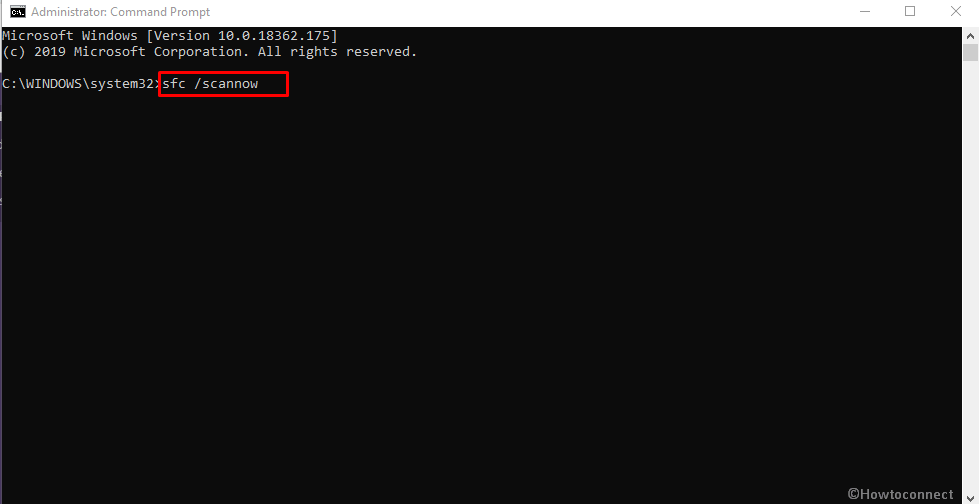
4] Make time to update all the Device Drivers Now
BSOD errors like IRQL_GT_ZERO_AT_SYSTEM_SERVICE show up in the system mostly because having old, defective and outdated drivers. Usually, this is not logical to keep the vulnerable driver in the system in any condition. To update drivers, Windows Device Manager can be the best platform. The app makes the task whole easier a lot. You can see those outdated drivers in Yellow indication. See the process in the below steps –
- Press Win+R hotkeys to invoke the Run dialog first.
- In the wizard, write devmgmt.msc inside typing area.
- Hit Ok button located beneath the box.
- When Device Manager completely appears, look at the list closely in the console. Expand the device where you will see a yellow mark of exclamation.
- When driver list split up, perform a right click on driver having Yellow sign only.
- From the appearing menu, select Update driver option and let the process begin.
- After the procedure ends following the onscreen guidelines, you will probably resolve IRQL GT ZERO AT SYSTEM SERVICE.

5] Diminish all Malware using Windows Security
Virus components are living everywhere in huge number. Mostly they are in disguise inside a suspicious site or a malicious link coming in Spam email. Inserting USB without checking can be risky as well. Whenever they get a chance to penetrate the security, enter into our system. In the meantime, infects and corrupts lots of necessary OS resources and IRQL GT ZERO AT SYSTEM SERVICE like BSOD errors show up. To stop this, we need to launch Windows Security which is a default anti-malware program and dismiss them. Here is the process below –
Step#-1: click on Windows Security Shield icon and let the app appear.
Step#-3: Once the app unrolls, select the Virus & threat protection lying in the left-hand side.
Step#-4: Switch to the right pane and make a click on the link saying Scan options.
Step#-5: Once all the method show up, Select Full scan radio button followed by a hitting a click on the Scan now.
Step#-6: Now, Windows Security will now start detecting for any virus component in the system. Once the scan gets over, the result will be displayed on the screen.
Step#-7: If there are any traces of malware, do a click Clean threats button to get rid of them from the system.
Step#-8: When the consequent page loads, the app will offer you three actions for the threat. Choose the Remove initially and then click on Start actions to initiate removal.
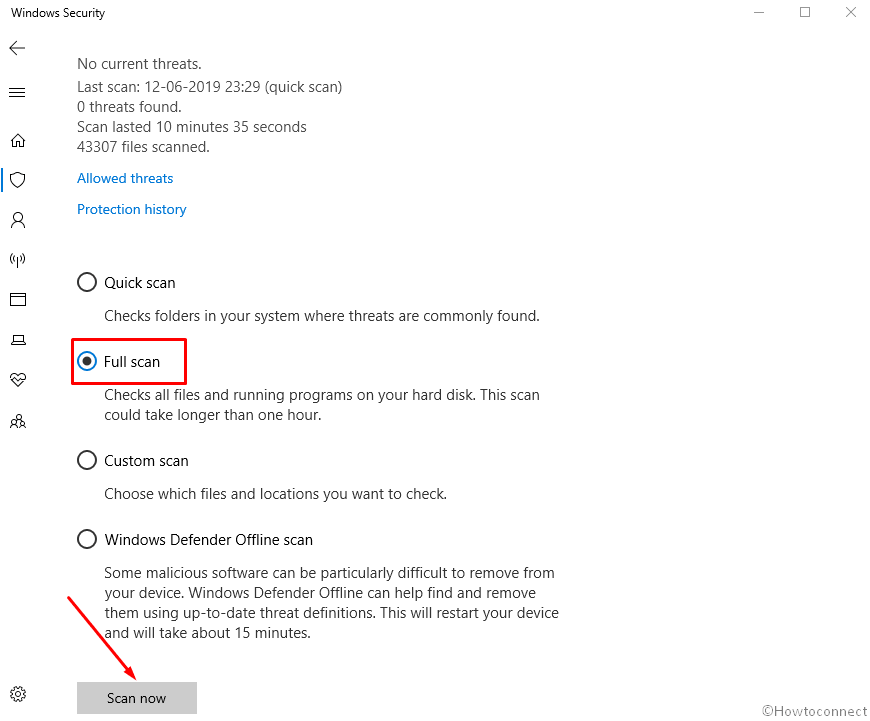
6] Perform Safe Boot to solve IRQL_GT_ZERO_AT_SYSTEM_SERVICE
In every critical issue Windows 10 come across, the first resolution can come in your mind is to Boot the device in Safe Mode. This is basically a special type of Startup method where windows loads only root applications. IRQL_GT_ZERO_AT_SYSTEM_SERVICE BSOD might get disappear when you deploy this workaround. To Boot the device in Safe Mode, guidelines are as following –
- Press the Windows key initially to open the Start menu.
- Hit the Gear cog to launch Windows Settings app.
- From the app window, select Update & Security and load its additional page.
- When the consequent page opens up, choose the Recovery option lying in the left overlay.
- Move to the adjacent right, find out Advanced startup and click Restart now button.
- After Windows completes the first cycle of rebooting, it will ask you to select the next step. Choose Troubleshoot from appearing screen.
- Moving ahead, make a click on Advanced options and then hit Startup Settings.
- Once Windows informs you that device can be restarted with the use of additional settings one of which is Enable Safe Mode, select Restart to move ahead.
- After signing back in on completing restarting the second time, Press f4 in order to Enable Safe Mode.
7] Increase the strength of Windows 10 by installing all update patches
All the update patches that Microsoft releases contain bug fixing codes. On the contrary, an outdated Operating System lacks this strength. As a result, it is very much prone to get affected by bugs and errors like IRQL_GT_ZERO_AT_SYSTEM_SERVICE BSOD. Hence, let’s install these available patches going through the following method-
- Click on Start icon.
- When Start menu arrives in the display, select Gear symbol.
- Choose Update & Security.
- Once the next page cuts your view, select Windows Update lying on the left pane.
- Transfer yourself to the corresponding right side and make a click on Check for updates. Ignore “You’re up to date” dialogue if you come across.
- When the patches are available, hit the Download button located under each patch.
- The installation of the patches will start automatically when downloading finishes.
- Follow the instruction windows provides like Restarting time to time until it gets installed.
Important – Connect the device you are using with Broadband Internet or Wifi to get high Downloading speed. This will reduce the time taken while downloading those files. If you have to use Mobile Hotspot, make sure to disable Metered Connection from Network settings.

8] Uninstall similar programs and restrict conflict
Having the same applications often become risky they tend to conflict with one another. This will also bring up IRQL_GT_ZERO_AT_SYSTEM_SERVICE BSOD in Windows 10. You can easily restrict this collision by uninstalling of them. You can remove a program from system using below guidelines –
- Roll the cursor to Start menu and make a right click on it.
- Choose Run from options to invoke the wizard.
- Type appwiz.cpl in the empty text space.
- Press Enter key to provoke Program and Features.
- Once all the Apps are available, reach out to programs causing conflicts with each other.
- Do right click on each and hit Uninstall option.
- If User Account Control prompts for authentication, select Yes to proceed.
- Follow the on-screen guidelines to finish the removal.
9] Run default Windows Blue Screen Troubleshooter
To minimize BSOD impacts Microsoft comes up with Windows Blue Screen Troubleshooter. Follow the below guidelines and apply the tool –
- Open Windows Settings.
- While in the App UI, proceed to Update & Security.
- Select Troubleshoot from the left-hand side and navigate to the adjacent right.
- Click on Blue Screen.
- Hit Run the Troubleshooter once come in the view from the expanded panel.
10] Perform a cycle of disconnecting and reconnecting external hard Disk drive
Some people have come across IRQL_GT_ZERO_AT_SYSTEM_SERVICE BSOD just after started using an additional HDD. As nowadays these things are quite handy, we cannot recommend keeping them left along. Amazingly, the issue resolved when you will disconnect the device. What we understood is, we need to offer a temporary break to the connection. Afterward, you can reconnect using the below guidelines –
- First of all, unplug External Hard drive from the computer.
- Now, Open the Start menu by pressing the Windows key.
- Hit Power cog and select Restart eventually.
- After the device completes the rebooting, check if there is any BSOD error in the system.
- If it resolves properly, plug the devices back in.
- Launch the web browser from Desktop and do a visit to their makers’ website.
- Thereafter, Download and Install the updated drivers for web page and use them easily.
11] Access Windows Memory Diagnostic and put an end to all Memory problems
Incorrect allocation of Memory devices and defective RAM altogether called Memory problems in Windows. This will play a big role in causing IRQL_GT_ZERO_AT_SYSTEM_SERVICE BSOD. For these sorts of problems, Windows Memory Diagnostic comes handy. To accomplish, move with below proceedings –
- Launch the Windows Settings app first using any convenient instructions.
- When the app launches, type memory in the search box located in UI.
- Select “Diagnose your computer’s memory problems” from the visible result.
- Immediately, Windows Memory Diagnostic will prompt up.
- From the subsequent wizard, hit the “Restart now and check for problems (recommended)” option.
- With the action, windows will undergo in restarting initially.
- When powering up again, the desktop screen will have a blue display detecting memory problems.
- When it hits to 100%, windows will restart for the second time automatically.
- After you it gets back to operation again, the result of the diagnosis will be displayed in the Notification area of System Tray.

12] Uninstall Defective Windows Update Files to fix IRQL GT ZERO AT SYSTEM SERVICE
Usually, the Windows Update process going through the Settings app is an autonomous one. This will rarely end up in the corruption or termination at midway while installing. But if sometimes that happens, may lead to IRQL_GT_ZERO_AT_SYSTEM_SERVICE BSOD. To eliminate the risk, we have to uninstall these dreadful files immediately. Here is how to remove those update files –
- Press Windows Button from the keyboard and allow the opening of Start menu.
- Once visible on display, choose Gear cog. And launch the Windows Settings app.
- From App UI, move ahead to Update & Security tile and do a click on it.
- From the next window, select Windows Update and shift to the corresponding right.
- Here, perform a click on the View update history link and proceed to the next page.
- Select Uninstall updates link and let the windows unroll Installed Updates windows coming from Control Panel.
- Reach to the lastly received patch and click on it.
- Select Uninstall option loaded in the top ribbon.
- Keep following on-screen instruction until they get removed completely.
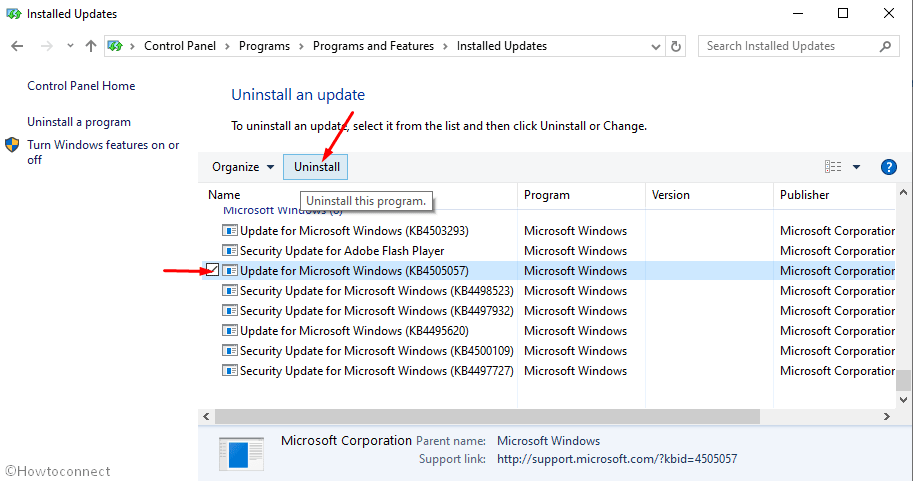
13] Fix up bad segments in Hard drive using Disk Checking tool
Using the Hard Disk for long causes making bad segments in it. The act is in a scene irrevocable. Since these areas might lead to IRQL_GT_ZERO_AT_SYSTEM_SERVICE BSOD finally, you need to fix them. Default Disk Checking Utility beforehand can be useful in settling things down. To access the tool, you have to run Chkdsk in Elevated Command Prompt. Proceed with the below steps to accomplish the task –
- Press Win+S, type cmd.exe and then hit Enter.
- When Command Prompt appears in the result, choose Run as Administrator from the right flyout.
- Select Yes Once UAC prompts for your consent.
- When in the Black Elevated Prompt window, type following command line tool at the base of winking cursor –
chkdsk C: /f /r /x - Now, execute the command by pressing the Enter key.
- Disk checking utility will detect and fix those problematic areas automatically.
- When the method gets over, perform a Restart to windows.
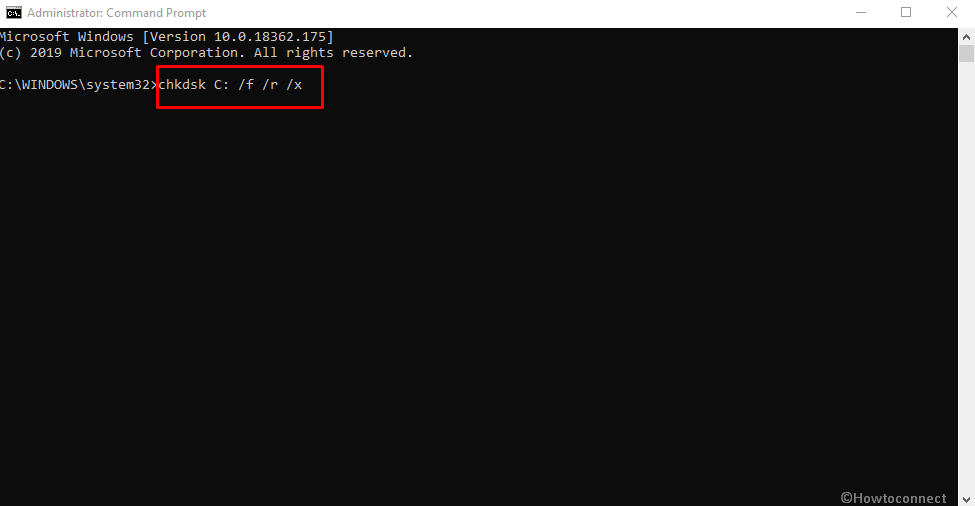
14] Do a System Restore to load back the Previous point
System Restore will guide you back to the point where there was no IRQL_GT_ZERO_AT_SYSTEM_SERVICE BSOD error. Why this happens actually is, whenever we make changes in a system, the windows registry tweaks. If anything goes wrong here, will definitely lead to Blue screen of Death errors. From that point, we can perform System Restore and load the previous state.
- Open the Taskbar search, type rstrui in the blank text area and then hit the Enter button.
- Once the System Restore Wizard appears on the screen, select Next to move ahead.
- From the following window, make a click on Show more restore points and reveal all the points.
- Choose the last one in the list and click on Next.
- After the following page cuts your view, hit Finish located at the bottom end and Start the process.
15] Delete Third party Anti-Virus programs
Before Windows Security made it way out, a lot of people were dependent on anti-malware programs. Most of them are free and quite well functional. Since the best tool in defending malware has arrived, all those third-party tools are unnecessary. Yet they can cause IRQL_GT_ZERO_AT_SYSTEM_SERVICE BSOD as well. We need to uninstall them using below guidelines –
- Press Win+I hotkey and open up the Windows Settings app.
- Choose Apps category.
- When the succeeding window opens, select Apps & features located at the left pane.
- Jumping on the Corresponding right side, reach third-party Anti-Virus Tool in the list.
- Select the same for expanding the view.
- Hit Uninstall option once seen in the pane.
- If UAC asks to authenticate, select Yes to proceed.
- Follow the guidelines available on display next to remove the tool completely.
16] Rectify defective Windows Image files using DISM tool
Windows Image Files are a bit sensitive and prone to fall in discrepancy. When these are Corrupted, IRQL_GT_ZERO_AT_SYSTEM_SERVICE BSOD occurs in the system. “Deployment Image Servicing and Management” DISM tool can efficaciously resolve these files. The utility powers up in the Elevated Command Prompt. You have to follow the below guidelines to use the tool –
- Manage entrance to Elevated Command Prompt using the same guidelines shown above.
- When in the Dark window, type the following command at the place where a cursor is blinking –
DISM.exe /Online /Cleanup-image /Restorehealth
- Press Enter to power up Deployment Image Servicing and Management (DISM) tool.
- The utility will rectify all the trouble windows image files eventually.
- This might be a longi one, but thoroughly helpful. So, do not terminate until it finishes normally.
- Once ends, restart the device and when signing back in, see if there is any BSOD error in the system.

17] Free up space using Disk Cleanup tool
Temporary execution files are created usually for completing a task in windows. They are stored in storage like others and really come to no use afterward. Once piled up largely, they will occupy huge space in it. Thus, the disk runs in low space and issues like IRQL_GT_ZERO_AT_SYSTEM_SERVICE BSOD show up. You can easily delete these unnecessary files using Disk Cleanup tool. Thus BSOD error will not be there and you will also have more space in the disk. Here is how to use the utility –
- Invoke the Run dialog by pressing Win+R hotkey together.
- In the box offered here, type cleanmgr and hit the Enter key as well.
- Select C: by clicking on the dropdown menu on the tiny popup and then choose Ok from the dialog.
- The Disk Cleanup utility will start calculating the amount of space it can recover from junk. Now, from the visible wizard, select Clean up system files option.
- The small popup will prompt up again asking to choose the drive. Choose C: again using dropdown menu and press Enter key.
- Now, in the Disk Cleanup for (C:) wizard, go to Files to delete section and check all boxes except Downloads.
- Hit the Ok button from the bottom and let the cleanup begin.
- This process might take a good amount of time. Hold patience accordingly and let it get over normally.
- When the procedure ends up, Restart Windows and after signing back in, check if the error persists.
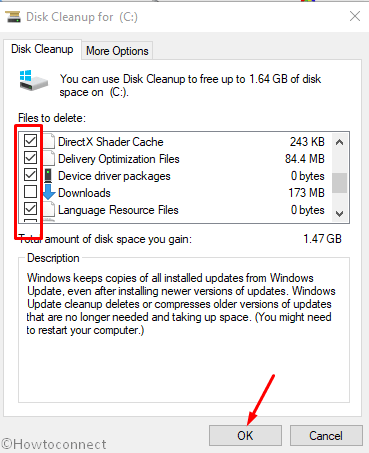
Hereby, we have discussed almost all the possible Workarounds those can potentially remove IRQL_GT_ZERO_AT_SYSTEM_SERVICE BSOD in Windows 10. The resolutions are proven to be effective ones. Unfortunately, if no positive comes up, don’t lose hope. You can still recover the PC by performing Clean installation of Windows 10. This will be the ultimate solution for all and if done correctly, you can have a flawless windows Operating System.
Methods:
1] Restrict the device from Restarting Automatically
2] Step up to make the BIOS of your System up to date
3] Heal the Corrupted System resources
4] Make time to update all the Device Drivers Now
5] Diminish all Malware using Windows Security
6] Perform Safe Boot
7] Increase the strength of Windows 10 by installing all update patches
8] Uninstall similar programs and restrict conflict
9] Run default Windows Blue Screen Troubleshooter
10] Perform a cycle of disconnecting and reconnecting external hard Disk drive
11] Access Windows Memory Diagnostic
12] Uninstall Defective Windows Update Files
13] Fix up bad segments in Hard drive using Disk Checking tool
14] Do a System Restore
15] Delete Third party Anti-Virus programs
16] Rectify defective Windows Image files using DISM tool
17] Free up space using Disk Cleanup tool
That’s All!!
